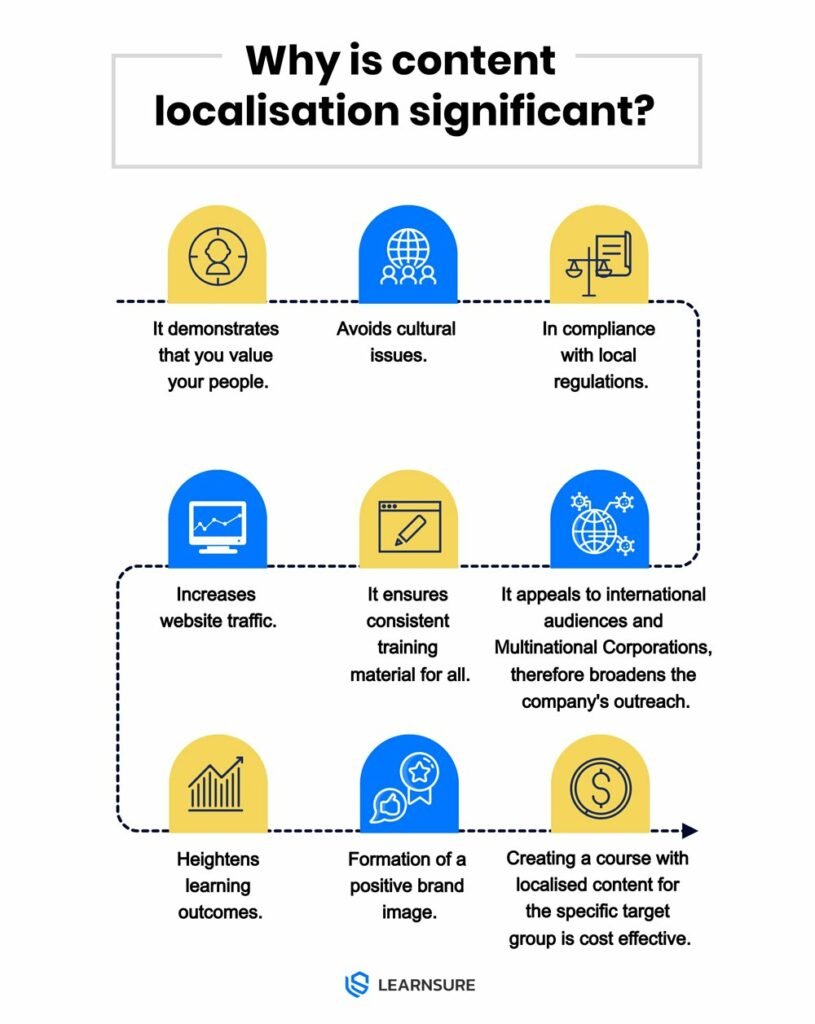Importance of content localisation and translation?
Why bother with content localisation?
After all, most of the people you’re selling the training to speak English. By incorporating translation into your content strategy, you’re just spending money on something that few people will use, right?
That isn’t the case.
Each year, the research group Common Sense Advisory publishes a report named Can’t Read, Won’t Buy. This report takes massive samples from several countries to determine whether people who speak languages other than English trust the English content they read enough to make purchases based on it.
The results of the 2020 release of this report show that 40% of people won’t buy a product if its related content is presented in another language. Furthermore, 65% said they preferred to read content in their own language, with 73% saying they wanted to see product reviews in their own language.
However, perhaps the most shocking statistic is that 65% of people prefer content written in their own language even if the content is of poor quality.
The message is simple:
If you hope to appeal to an international audience, content localisation must be a priority. Building on this, if you are creating digital learning experiences for a multi-national company, you must implement content localisation to achieve better learning outcomes.
In this article, we dig deeper into the reasons for content localisation and translation to make the case for why you should implement these techniques into your content strategy.

Reason No. 1 – Cost-Effectively Broaden Your Reach
Through content localisation, you broaden the reach of your training materials so they can be used in every department of the company, regardless of its location. Not only does this make your training programs more effective, but it also reduces the cost of training.
How?
If you do not localize your content, you may have to invest money to develop completely new training materials for students in other countries. Alternatively, you end up relying on training programs that employees don’t fully understand. The potential outcome is having a group of employees who aren’t clear about what their roles entail, leading to lower production levels that ultimately create costs for the organisation.
But by focusing on localising existing content, your company reduces its costs while providing more valuable materials to its people.
Reason No. 2 – Demonstrate That You Value Your People
As mentioned, the vast majority of people prefer to learn from content written in their own language. By providing untranslated content to them, you’re implying that their needs and wants are not as important as your desire to save money on the cost of content localisation.
Through translation, you demonstrate that you value the needs of your people. Your commitment to them is repaid by having employees who are more engaged and motivated to do their jobs. Furthermore, your people will retain more of the information they learn, meaning they’re also more capable in addition to feeling more engaged with your organization.
Finally, demonstrating that you care about your people is useful from a branding perspective. Your organization can use its localization efforts to highlight its inclusive values, leading to deeper engagement from both employees and your clients.
Reason No. 3 – Avoiding Cultural Issues
You may believe that using automated content localisation software may remedy the language issues without the need for monetary investment. For example, Google’s Chrome browser automatically translates websites delivered in other languages to the user’s chosen language. Perhaps you could rely on similar technology to automate your content localisation?
Unfortunately, this is a dangerous route to take.
There are several examples of companies that delivered culturally inappropriate content to their international customers due to poor translation efforts. The Swedish furniture company IKEA experienced this first hand when it attempted to break into the Thai market. Poor localization of its product names resulted in one of its items being labelled as the Thai equivalent of “getting to third base”. Coors experienced a similar issue when trying to localize its “Turn it loose” slogan to Spanish markets. In their case, the result was a slogan that translated to a slang term for diarrhoea.
The point is that relying on automation to localize content without direct involvement from a localization team can lead to misunderstandings and poor translations. When selling a product, these issues could make your organization a laughing stock. Similarly, poor translation in your training solutions may mean that employees do not learn the information they need to do their jobs.
Reason No. 4 – Compliance With Regulations
In 2012, the Canadian online clothing retailer Anthropologie decided that it wanted to expand its business into the predominantly French-speaking province of Quebec. The company failed to dedicate enough resources to content localisation before its new website launch.
The result was that authorities in Quebec shut the website down because it failed to meet the province’s language-based regulations. Anthropologie was then forced to divert users in Quebec to its physical store in Montreal.
This story demonstrates that many countries, provinces, and regions have regulations in place for websites and e-learning portals. If you fail to translate your website’s content effectively, your site may get closed down. With high-quality content localisation, you avoid these types of regulatory issues.
Reason No. 5 – Increased Website Traffic
In 2015, online marketing expert Neil Patel decided to translate his website into 82 different languages. The result was a 47% increase in website traffic for neilpatel.com.
More traffic to a website means more opportunities to make sales because you’re attracting a larger audience. By including content localisation in your website’s content strategy, you broaden your consumer base, which can lead to higher engagement and more sales.
Reason No. 6 – Consistent Training Materials
By focusing on content localisation, you also ensure that all of the training materials presented to your people are consistent with what your organization requires from them. A lack of consistency, which may occur if you rely on third-party organizations to deliver separate training, could lead to your people misunderstanding their roles. It could even lead to failure to maintain compliance in more sensitive industries.
You maintain control of your training program through localisation.
Speak in Their Language
By expecting your website and digital learning platform users to adapt to a non-native language, you reduce the effectiveness of your content. The simple fact is that people prefer to read content in their native languages, with this preference translating to direct benefits for your business.
With content localisation, the website traffic and engagement increase, leading to more sales. You also ensure your platforms comply with local regulations, in addition to avoiding the cultural issues that can arise from both poor translations and the user’s inability to properly understand the content presented.
This need for localization applies to your online training solutions as much as it applies to the consumer-facing side of your organization. By translating training materials, you also achieve an increase in engagement that leads to improved employee performance in your international divisions.

